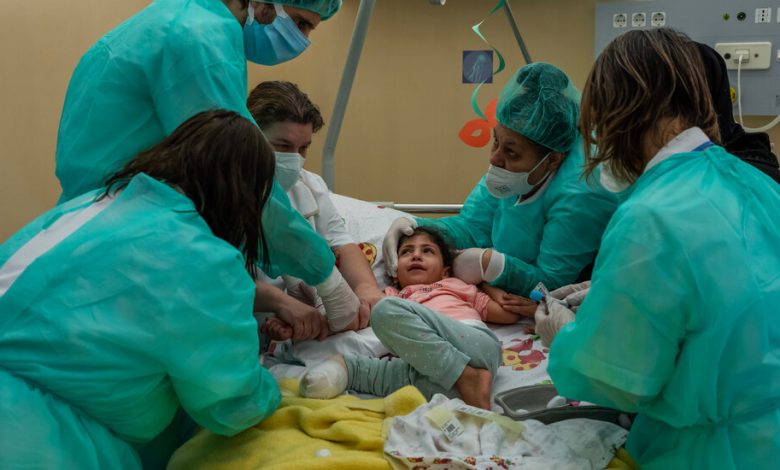The First Flight of Their Lives: An Airlift After Agony in Gaza





Shaymaa Shady, 5, had her first amputation in January, after an explosion erupted by her family’s house in Gaza where she and relatives were resting.
Sarah Yusuf, also 5, suffered burns and broke her leg and pelvis when her town was bombarded by Israel in November.
Abdel Rahman Mady, 19, fractured his spine, partly paralyzing him, during an attack that killed more than two dozen members of his family.
They were three of 16 young people, all but one younger than 15, who were taken out of Gaza and then airlifted to hospitals in Italy.
The First Flight of Their Lives: An Airlift After Agony in Gaza
Photographs by Nariman El-Mofty
Text by Nariman El-Mofty and Alan Yuhas
Nariman El-Mofty spent eight days with a group of Gazan children and their caretakers and joined them on an Italian military flight from Cairo to Rome, then to Pisa, Italy. She traveled with two families in ambulances to a hospital in Bologna, Italy, where the children are receiving treatment.
Each of the children survived horrors. Each lost relatives in the strikes that injured them. All have struggled with the emotions of what they went through and what they face ahead.
The evacuees make up only a tiny fraction of the thousands of civilians, including many children, who have suffered grievous injuries over the course of Israel’s monthslong campaign against Hamas and its bombardment of Gaza. Health officials in the territory say that more than 31,000 Gazans have been killed since the war began on Oct. 7, in response to the attack that Hamas led against Israel. Experts say that children are particularly vulnerable to burns and serious injuries from high-intensity attacks, especially in a crowded, urban environment like Gaza.
The explosion that injured Shaymaa, 5, in the southern Gazan village of Al Mawasi in January, killed her grandmother, badly injured her grandfather and mangled the girl’s foot, according to Lina Gamal, Shaymaa’s aunt.
Shaymaa was rushed to Nasser Hospital, where doctors quickly decided to amputate. They no longer had anesthesia, alcohol or other means to clean the wound, forcing the doctors to rinse it with murky water. They performed a rapid surgery and hurried to help other wounded people crowding the halls, Ms. Gamal said.
For three days, Ms. Gamal said, Shaymaa was “always screaming.”
Ms. Gamal stayed at her niece’s side through sleepless nights. Like many others, she registered the injured child for a chance to evacuate, through aid groups and several governments, to a hospital abroad — maybe Qatar, the United Arab Emirates, Turkey or Italy. Ms. Gamal offered herself as a caretaker, as Shaymaa’s parents needed to look after her siblings.
It was not until February, after lengthy background checks and negotiations — between officials of those countries and Egypt and Israel, as well as aid groups — that Shaymaa learned she was in the small group selected to evacuate, Ms. Gamal said. From around Gaza, the children and their caretakers journeyed toward the border city of Rafah, facing Israeli shelling and desperate competition for food, Ms. Gamal said. From there they crossed into Egypt, where they were airlifted to Italy, on what for all of them was the first flight of their lives.
